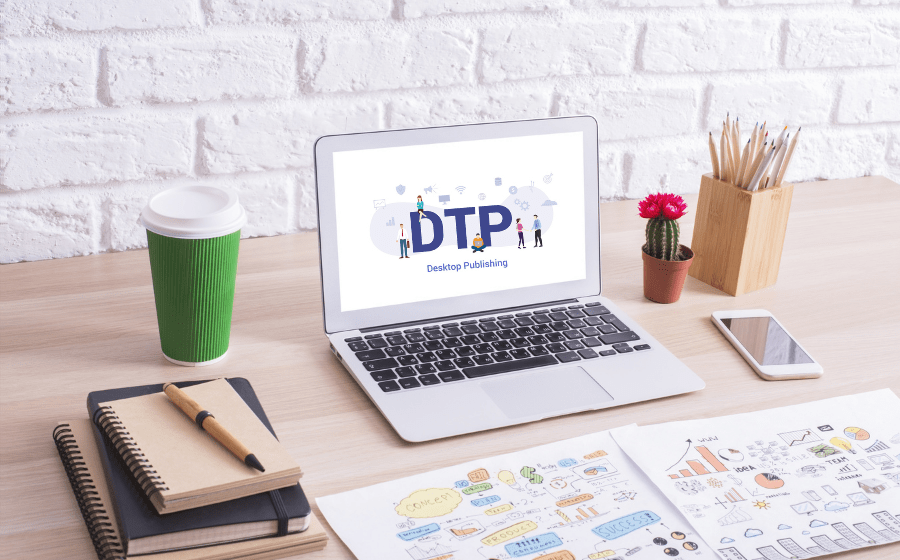Working with translators alone may not be enough if you need to translate a website or high-visual products such as brochures, flyers, or presentations into a new language. You may require an additional service known as desktop publishing to improve the layout of the translated versions.
So, what exactly is desktop publishing, and what obstacles can you face if you use it? In today\’s post, we\’ll look for solutions to these critical issues.
What is Desktop Publishing?
Desktop Publishing (or DTP) is the process of developing page layouts and high-quality printed documents on a computer using page layout software. Initially, desktop publishing was only used for print publications. Newspapers, periodicals, brochures, pamphlets, and menus are examples of common desktop publishing products. However, as the Internet has grown in popularity, so has the use of DTP. It aids in the transmission of many sorts of online content, such as white papers, newsletters, web content, web pages, and so on.
Challenges in Desktop Publishing
Without a doubt, skilled translators are essential for correct translation. Unfortunately, in order to generate a high-quality end-result, it is sometimes necessary to move beyond language considerations. Many things can go wrong during the desktop publishing process, which has a negative impact on the final product layout. Font conflicts, word growth, and incorrect images are all prevalent problems in DTP.
1. Fonts
Font conflicts can be a source of frustration for any desktop publisher, regardless of their level of experience. Your font may operate flawlessly in English, but issues arise when you convert your text into tonal languages like Vietnamese or into a foreign writing system like Japanese, Chinese, or Thai. In general, your preferred font may not be available in all languages. This indicates that a modification in the typeface used for the target language papers is unavoidable in order to provide legible final documents.
To address the first challenge, skilled desktop publishers can offer clients with a list of fonts that appear similar to the original or are appropriate for the content. Alternatively, your organization can select some from the list, or you can create your own list and provide it to the linguists. An agreement between the two parties in this step will aid the desktop publishing process.
2. Word Length
In language translation, there is no such thing as a one-to-one correspondence. The length of translated words might shrink or expand substantially when compared to the original language, resulting in either a lack of or an abundance of white space. For example, Italian text can be three times larger than the same content in English, although Chinese word length is reduced by about 20% when translated from English.
3. The Nature of Languages
Because of the nature of the target language, the entire layout of a document is sometimes modified. Most languages, for example, are written from left to right on the page. Languages such as Arabic, on the other hand, are read and written from right to left. As a result, the source document\’s overall layout is no longer appropriate for the destination language.
4. Graphics & Background
Another consideration while undertaking desktop publishing is the localization of graphics and backdrops. Some of the graphics or illustrations in the source file may be culturally inappropriate for regional audiences, particularly in terms of color. For example, red is popular in many Asian cultures, whereas white and black are associated with bad luck or death. As a result, changing the hue or finding new photos is strongly advised.
During the desktop publishing, images may not be displayed properly in the software, causing desktop publishers to spend a significant amount of time looking for alternatives. Aside from content, image resolution must match that of other sections in the file. Otherwise, the quality of the printed file will be inconsistent.
Wrap Up
For any translation project that contains high levels of graphics and visuals, desktop publishing is indispensable. If you need professional desktop publishing services for your translation projects, contact the DTP Labs team now. We have a team of experienced desktop publishers who make use of a wide range of desktop publishing software (e.g. Adobe InDesign, Adobe Photoshop, Adobe Illustrator, etc.) to give you the neatest and most eye-catching content. We support all major languages in the world. DTP Labs is one of those trustworthy agencies that you can rely on. As a professional DTP localization agency, DTP Labs offers high-quality desktop publishing services at the most cost-saving price through skilled native DTP operators.
Contact us at info@dtplabs.com

